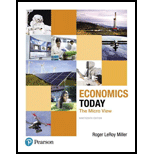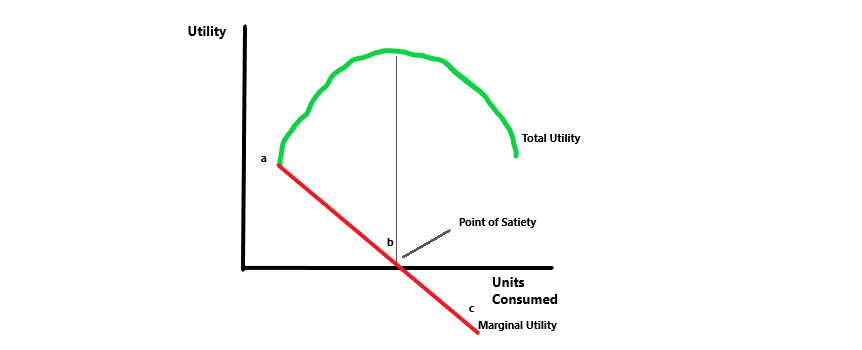
The difference between total and
Concept Introduction:
Utility refers to the amount of satisfaction a consumer gets from the consumption of a good or service. It can also be defined as the quality of the good to satisfy human wants. Utility is measured in terms of money and is thus, a relative concept.
Explanation of Solution
Total Utility refers to the total amount of satisfaction derived from the consumption of a good. It is the total satisfaction obtained from different units of the commodity.

While Marginal utility refers to the addition to the total utility when one more unit of a good is consumed. In other words, it is the additional utility derived from consuming one additional commodity.

Where,
 - is the change in total utility
- is the change in total utility
 - is the change in quantity of good consumed
- is the change in quantity of good consumed
Law of diminishing marginal utility explains why marginal utility falls as a person consumes more of a good. This law states that the more we have of a commodity, the less we want to have more of it. As a consumer goes on consuming a particular commodity, each successive unit of the commodity will yield him less and less satisfaction.
For example, if we are very thirsty and buy a drink, the first drink will yield us maximum satisfaction as we really need the commodity at that time. After the consumption of the first drink, however, we are not thirsty anymore and we would not like to have another. The next additional drink will, therefore, give us less or negative satisfaction. Thus, satisfying the law of diminishing marginal utility. In the figure, below we can see that marginal utility or satisfaction from an additional utility is maximum at point a. Point b is the point of maximum satisfaction, at this point Total utility is maximum and marginal utility is zero. Any consumption beyond this point will result in a fall in total utility and cause marginal utility becomes negative.

Want to see more full solutions like this?
Chapter 20 Solutions
Economics Today: The Micro View (19th Edition) (Pearson Series in Economics)

 Principles of Economics (12th Edition)EconomicsISBN:9780134078779Author:Karl E. Case, Ray C. Fair, Sharon E. OsterPublisher:PEARSON
Principles of Economics (12th Edition)EconomicsISBN:9780134078779Author:Karl E. Case, Ray C. Fair, Sharon E. OsterPublisher:PEARSON Engineering Economy (17th Edition)EconomicsISBN:9780134870069Author:William G. Sullivan, Elin M. Wicks, C. Patrick KoellingPublisher:PEARSON
Engineering Economy (17th Edition)EconomicsISBN:9780134870069Author:William G. Sullivan, Elin M. Wicks, C. Patrick KoellingPublisher:PEARSON Principles of Economics (MindTap Course List)EconomicsISBN:9781305585126Author:N. Gregory MankiwPublisher:Cengage Learning
Principles of Economics (MindTap Course List)EconomicsISBN:9781305585126Author:N. Gregory MankiwPublisher:Cengage Learning Managerial Economics: A Problem Solving ApproachEconomicsISBN:9781337106665Author:Luke M. Froeb, Brian T. McCann, Michael R. Ward, Mike ShorPublisher:Cengage Learning
Managerial Economics: A Problem Solving ApproachEconomicsISBN:9781337106665Author:Luke M. Froeb, Brian T. McCann, Michael R. Ward, Mike ShorPublisher:Cengage Learning Managerial Economics & Business Strategy (Mcgraw-...EconomicsISBN:9781259290619Author:Michael Baye, Jeff PrincePublisher:McGraw-Hill Education
Managerial Economics & Business Strategy (Mcgraw-...EconomicsISBN:9781259290619Author:Michael Baye, Jeff PrincePublisher:McGraw-Hill Education





